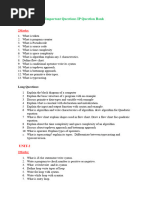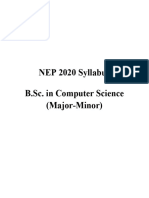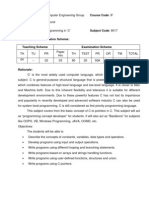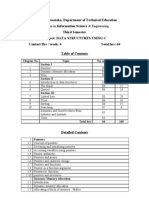0 ratings0% found this document useful (0 votes)
47 viewsProgramming for problem solving important questions
Uploaded by
abhinayajenny2007Copyright
© © All Rights Reserved
Available Formats
Download as PDF, TXT or read online on Scribd
0 ratings0% found this document useful (0 votes)
47 viewsProgramming for problem solving important questions
Uploaded by
abhinayajenny2007Copyright
© © All Rights Reserved
Available Formats
Download as PDF, TXT or read online on Scribd
You are on page 1/ 3
Programming for problem solving
Important Topic Chapter wise
Chapter -1
1. Definition of computer / and its related components (input/output..etc )
2. Definition of operating system
3. Definition of compiler, interpreter translators
4. Algorithm Definition and its characteristics
5. Any examples on algorithm (can ask anywhere from general topics) (Note: Pseudocode
and Algorithm are same but writing style is different)
6. Definition of flowchart and symbols (any general example may ask)
7. Definition of Source code, object code executable code or may ask difference between
them
8. Conversions (Binary to decimal….. ) (Note: Here there is a chance of asking program of
conversion (in rare case) )
9. Types of programming languages (Machine / assembly / high level)
Note: Max no programs asked in chapter -1 (May ask algorithm and flowcharts)
Chapter-2 (*** Very important chapter don’t miss reading)
1. Tokens (Keywords, constants, identifiers, variables and data types) (Here may ask one
topic as definition or as subtopics. But data types are very important)
2. Operators (may ask one at time or combination or all as long) (Note: Reading this topic
read as concept → syntax→Example or example program for each operator)
3. Statements
a. Condition
b. Iteration
c. Unconditional
(Note: for 3rd question follow same as 2 question as concept →syntax → example or example
programs. Remember here he may ask one statement at time or combination of single statement
like if, switch)
4. Definition of arrays
5. Types of arrays (1D and 2D)
6. Declaration of arrays and initialization of arrays (with syntax and examples)
7. Definition of Strings
8. Declaration and initialization of strings (with syntax and examples)
9. String manipulation functions
a. strcat( )
b. strcmp( )
c. strcpy( )
d. strlen( )
e. strrev( )
f. strlwr( )
g. strupr( )
h. strstr( )
i. strchr( )
Note: Maximum these functions may be asked, may ask like write any 4 or 3 as per marks
Read all function with concept→syntax→example→example program
10. String input output functions (get( ) / put( ))
Programs in chapter 2: (**There is max chance of asking programs. Remember these are only
repeatedly asked programs don’t think these programs may come. It for only for reference)
1. C program to check given year is leap year or not
2. C program to convert given days into years months and days
3. C program to print multiplication table of given number
4. C program to reverse of digits in given integer
5. C program to sum of digits in given integer
6. C program to check given number is palindrome or not
7. C program to check given number is Armstrong or not
8. C program to check given number is prime or not
9. C program to print prime numbers from one to N
10. C program to find cos(x)
11. C program to find sin(x)
12. C program to find Fibonacci series
13. C program to Maximum and Minimum element from given array of elements
14. C program to Sum and average of array numbers from given array
15. C program to find transpose of Matrix
16. C program to find addition / subtraction of two matrices
17. C program to Multiplication of two matrices
18. C program to count number of lines characters and words from given string
Chapter – 3
1. Bubble sort (Technique (concept) program)
2. Selection sort (Technique (concept) program)
3. Linear search (Technique (concept) program)
4. Binary search (Technique (concept) program)
5. Finding roots of Quadratic equation
Note: for above sorting and searching techniques, may ask to sort given set of array values by
giving some set of number as question. Here you have to perform step by step process of
sorting or searching.
6. Function definition
7. Types of functions (User defined / predefined functions)
8. Need to be done to declare user defined functions (Function call, function definition and
function declaration) (syntax and example)
9. Types of functions (with return type with arguments total 4 types)
10. Call by value and Call by reference (Concept and Example program)
**Programs in Chapter -3 may ask generally and learn some programs to convert to be
written as functions.
Chapter-4
1. Recursion definition
2. Applications of recursion
3. Types of recursion
4. Limitations of recursions
5. Learn concept of recursion with one example like factorial
6. Structure definition
7. Types of structure declarations (Syntax and example)
8. Difference between structure and arrays (Syntax and example)
9. Structure arithmetic (Syntax and example)
10. Array of structure (Syntax and example)
11. Array in structure (Syntax and example)
12. Union definition
13. Structure and Union difference
Programs in Chapter-4
1. C program to find factorial of given number using recursion
2. C program to find Fibonacci series
3. Example programs on declaring structure / initialization example accessing structure
variable
4. Example programs of array of structure
5. Example program on union
Chapter -5
1. Pointer definition
2. Pointer arithmetic
3. Example programs on use of pointers
4. Self-referential structures (concept → syntax→ example)
5. Linked list (concept → syntax)
6. File definition
7. Types of files
8. File operations
a. Open a file
b. Read data from or to file (fopen () )
c. Print data from or to file (fprintf( ), fscanf( ), fgets( ), fputs( )..)
d. Close a file (fclose( ))
9. File opening modes
10. File status functions (fseek( ), rewind( ), ftell( ))
11. File error function (ferror( ), fEOF, EOF)
Programs on Chapter-5
1. Example programs on pointer
2. C program to Reading data from file
3. C program to print data to file
You might also like
- American - Family and Friends Grade.3 Lesson - Plans PDF100% (1)American - Family and Friends Grade.3 Lesson - Plans PDF363 pages
- Important Que List (Chapterwise) (Chapters 1 To 11 ANSI C)50% (2)Important Que List (Chapterwise) (Chapters 1 To 11 ANSI C)9 pages
- Introduction to Programming Important Revised QuestionsNo ratings yetIntroduction to Programming Important Revised Questions5 pages
- 1. WIMS 2021_COMPUTER PROGRAMMING_HANDOTNo ratings yet1. WIMS 2021_COMPUTER PROGRAMMING_HANDOT10 pages
- Important Questions For Viva Programming in C: Chapter 1: IntroductionNo ratings yetImportant Questions For Viva Programming in C: Chapter 1: Introduction5 pages
- Question Bank Programming For Problem Solving BTPS101-18No ratings yetQuestion Bank Programming For Problem Solving BTPS101-182 pages
- Model_paper_1_dean_Format_Final.docx - Google DocsNo ratings yetModel_paper_1_dean_Format_Final.docx - Google Docs4 pages
- TS Programming in C Final 23-01-2022 With Preface0% (1)TS Programming in C Final 23-01-2022 With Preface192 pages
- VerX Safety Verification of Smart ContractsNo ratings yetVerX Safety Verification of Smart Contracts17 pages
- Inverse Functions - Worksheet: Find: ( )No ratings yetInverse Functions - Worksheet: Find: ( )10 pages
- Neurobiology Research Findings: How The Brain Works During ReadingNo ratings yetNeurobiology Research Findings: How The Brain Works During Reading18 pages
- Bài Tập Ngữ Pháp Lớp Giao Tiếp in 25 BảnNo ratings yetBài Tập Ngữ Pháp Lớp Giao Tiếp in 25 Bản48 pages
- Quicksort: Pseudo Code For Recursive Quicksort FunctionNo ratings yetQuicksort: Pseudo Code For Recursive Quicksort Function11 pages
- Notes - Julius Caesar - Act - I - Scene - 02No ratings yetNotes - Julius Caesar - Act - I - Scene - 023 pages
- BCOBM122 Applied Data Analytics - Midterm Task Brief - 2024 - Part 2DANo ratings yetBCOBM122 Applied Data Analytics - Midterm Task Brief - 2024 - Part 2DA5 pages
- Disha Publication Shortcut On Alphabet and Number TestNo ratings yetDisha Publication Shortcut On Alphabet and Number Test8 pages

























































































